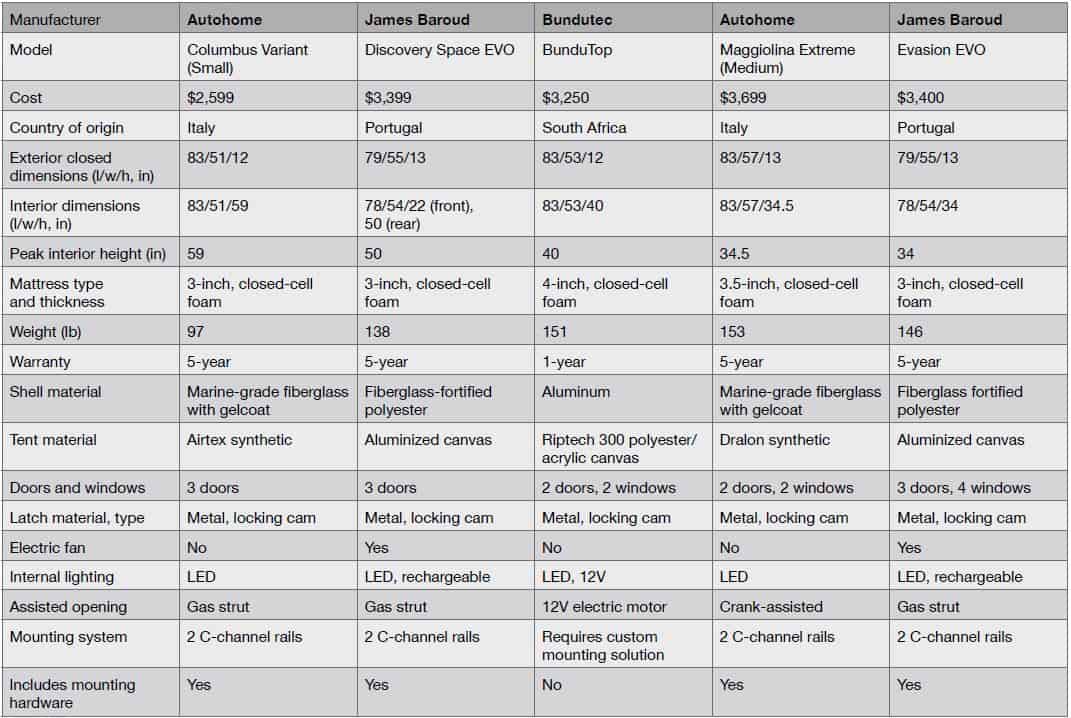Editor’s Note: This article was originally published in Overland Journal, Gear Guide 2016.
The mere mention of the word overlanding is often enough to evoke images of sunsets on the Serengeti, the silhouette of a truck marked for adventure by the outline of a roof top tent. Although roof sleeping is not commensurate with overlanding, removing the tent from that scene quickly erodes the idyllic picture. More than just a stylish accessory, they have been used for over a half-century and are favored for good reason.
For those apt to travel in regions of the world where toothy creatures and things that slither lie in wait, retreating to an enclosed platform 6 feet off the ground provides peace of mind. Roof top tents also simplify camp setup and are unaffected by rocky, muddy, snow-covered, or uneven ground. They’re typically quite comfortable, weatherproof, and offer a great view when the first rays of morning light crest the horizon.
With the roof top tent market expanding, it appears their benefits are well known. What may not be as evident is why anyone would choose a hard shell tent over the more ubiquitous soft-sided versions. Those who opt to travel with a hard shell tent refer to a handful of compelling justifications. The primary advantage is the convenience of setup. Whereas a soft tent invariably requires the removal of a heavy protective cover, the hard shell does not. Even after being unfolded, a process that in itself can be laborious, a soft tent frequently requires additional steps to be completed. For the hard shell user, the procedure seldom includes more than the release of a few latches and the installation of a ladder.
Other perks include a more aerodynamic shape for optimal fuel economy and reduced wind noise at highway speeds. Another benefit common to every hard shell tent we tested is the extra internal volume which can be used to store blankets, pillows, and other slumber essentials, even when collapsed. The more stylized enclosures also compliment the shape of newer vehicles, looking completely at home on everything from a Range Rover MK IV to a Grand Cherokee.
For this test we evaluated five hard shell models suitable for vehicles or trailers; the latter application is becoming more popular with the passing of each season. Although tents come in a variety of sizes—some capable of sleeping a small family of four—we selected tents suitable for two adults.
As crowded as the soft shell tent market is, the North American hard shell buyer is unfortunately not spoiled for choice. On the upshot, the few tents available are high-quality offerings with innovative features. The Italian Autohome brand, makers of Maggiolina and Columbus tents, has been in the roof top tent business since they invented the category in 1958. By no means a newcomer to the segment, the Portuguese James Baroud company has made a strong entry into the Americas with a comprehensive line of shelters, the majority of them built with hard shells. The most unique tent in our test is the South African BunduTop from Bundutec. With its electric assist deployment and all-metal body, it is an interesting departure from the norm. We had hoped to include the American Roost tent, but they declined involvement due to a restructuring of their company and impending product redesign. The one other tent we considered was the Impi from Hannibal; however, in response to limited and often disrupted distribution, we felt it unnecessary to review a product so difficult for consumers to obtain.

With our selection of five acquired, we developed a battery of tests to isolate and measure the objective and subjective qualities of each design. Employing our standard testing protocols, we first set out to evaluate each unit where it matters most—in the backcountry. It is often in these real-world settings where various features present themselves as either redeeming attributes or annoying peccadilloes. It is one thing to test weatherproofness with a garden hose, but waiting out a rainstorm from dusk until dawn is decidedly more telling.
In an effort to not overcomplicate our appraisals, we divided our evaluations into four distinct categories: ease of use and features, comfort, storm-worthiness, and overall quality. With just six months time to complete this project, it was difficult to gauge durability, but all five tents will continue to be used by our staff over the next year, affording an opportunity to see how each unit holds up with long-term application in the field.
Our checklist of observations and metrics eventually swelled to more than two dozen considerations. Experience has taught us to never overlook the little things. We measured wind noise at highway speed, inspected seams for poor stitching, and listened for squeaks and noises when moving about the interior of each shelter. Notations were made if the ladder flexed or felt unstable. Ventilation was carefully scrutinized as was the configuration of the doors and windows. We even tested buckles and latches with and without gloved hands. Before this begins to sound like a thankless job, it did afford us ample time and excuse to go camping. That might be our favorite attribute of any tent.
AUTOHOME
Columbus Variant, Small $2,599

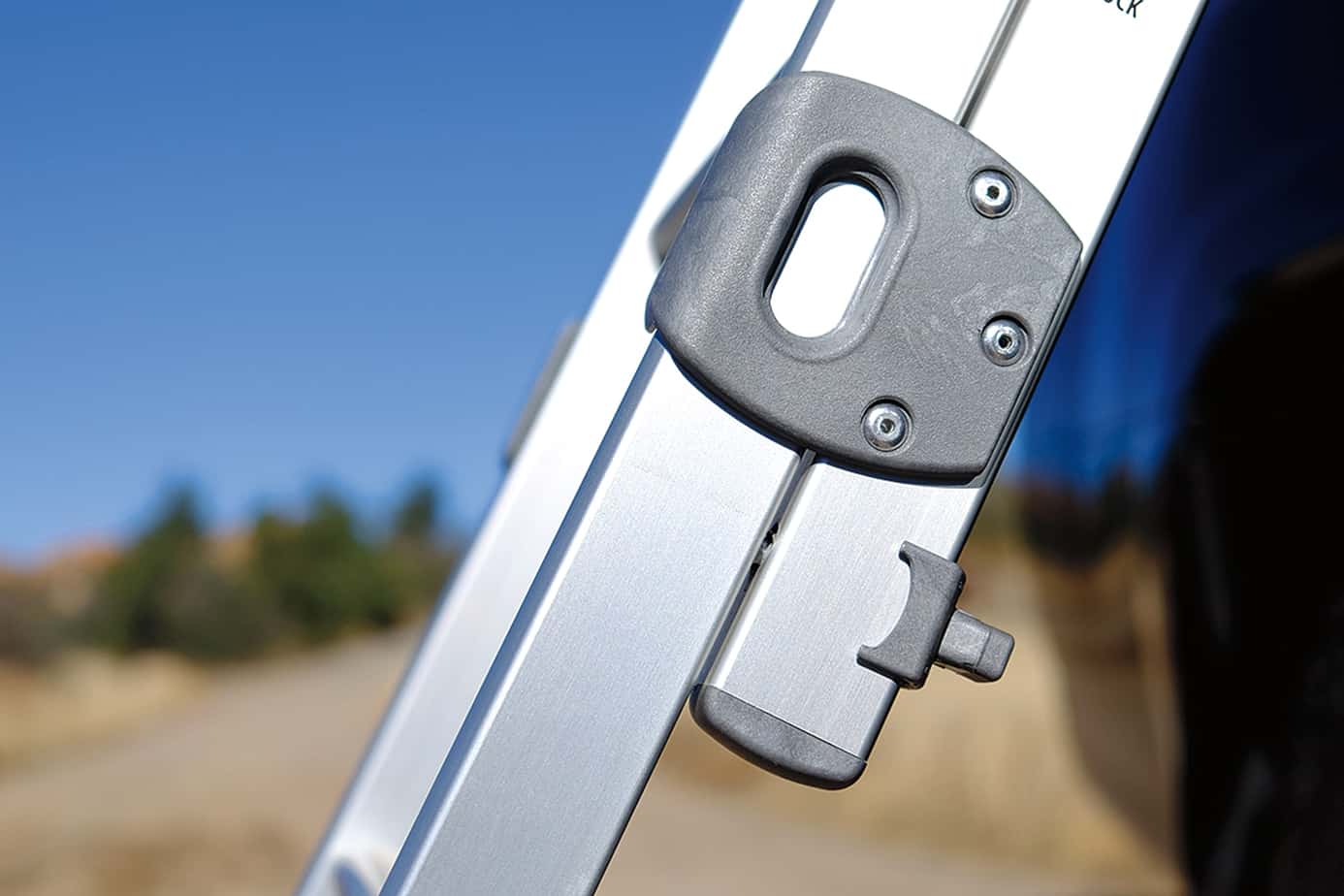


Over the course of the last few years there has been an increasing demand for compact roof tents. The advantages to light roof loads are universal, but the obvious catalyst for this new trend can be credited to the downsizing of vehicles used by a growing number of travelers.
The Columbus Variant in its smallest of three sizes is more than just space efficient and offers a level of simplicity prized by many users. The single-ended hinge configuration reduces complexity, requiring only two lateral struts to elevate one half of the upper shell. Despite the fact it virtually eliminates headspace at one end, it permits a tall peak at the other. At a maximum of 59 inches tall, that extra height allows occupants to sit up or kneel, making menial tasks like changing clothes less awkward. The wedge-shaped architecture also allows the unit to be parked with the hard-shelled wall of the tent pointed directly toward oncoming wind and weather.
The two sides of the tent have full-size doors, each backed with a second layer of mesh netting. Autohome employs a simple, if not slightly peculiar band of clear, narrow plastic along the zipper tracks to shield them from the threat of moisture. At the back of the tent is the largest door, also paired to a mesh panel and an additional layer of clear plastic, allowing the ingress of natural light while keeping the habitat sealed from the elements. Helping to minimize condensation and improve airflow is a shrouded vent located at the top of the rear door. Further adding to the breathability of the tent, the side walls are constructed of light, durable Airtex synthetic canvas. Inside, accessories include a 3-element LED light, two plush pillows, and a large storage net mounted to the lined ceiling.
In use, the Columbus Variant is quicker to set up than any tent we have ever tested. Deployment requires one hand and the release of a single latch as two gas-filled rams lift the upper shell into place. The final steps involve the placement of the ladder, and locking the internal struts via two small threaded knobs. The entire procedure, start to finish, takes less than a minute with little to no practice. Collapsing the structure is equally uncomplicated.
At only 97 pounds with a footprint that fits nicely within the limits of most rooflines, the Variant is an ideal choice for smaller vehicles. As expected, the tent’s interior is decidedly snug for two adults, and the wedge shape did have one noticeable drawback: our testers noticed their feet constantly contacted the hard upper shell. It does have a cramped foot box, particularly for taller users with bigger feet.
That one minor niggle aside, we were pleased with the mattress comfort, appreciated the overall simplicity of design, and found fit and finish to be superb. Passing all of our weather tests with aplomb, the Columbus Variant was also the quietest of all tents in our highway wind noise tests. With ample room to store blankets and pillows within the closed case, this tent is our preferred compact solution. autohomeus.com, 888-852-2359
JAMES BAROUD
Discovery Space EVO $3,399
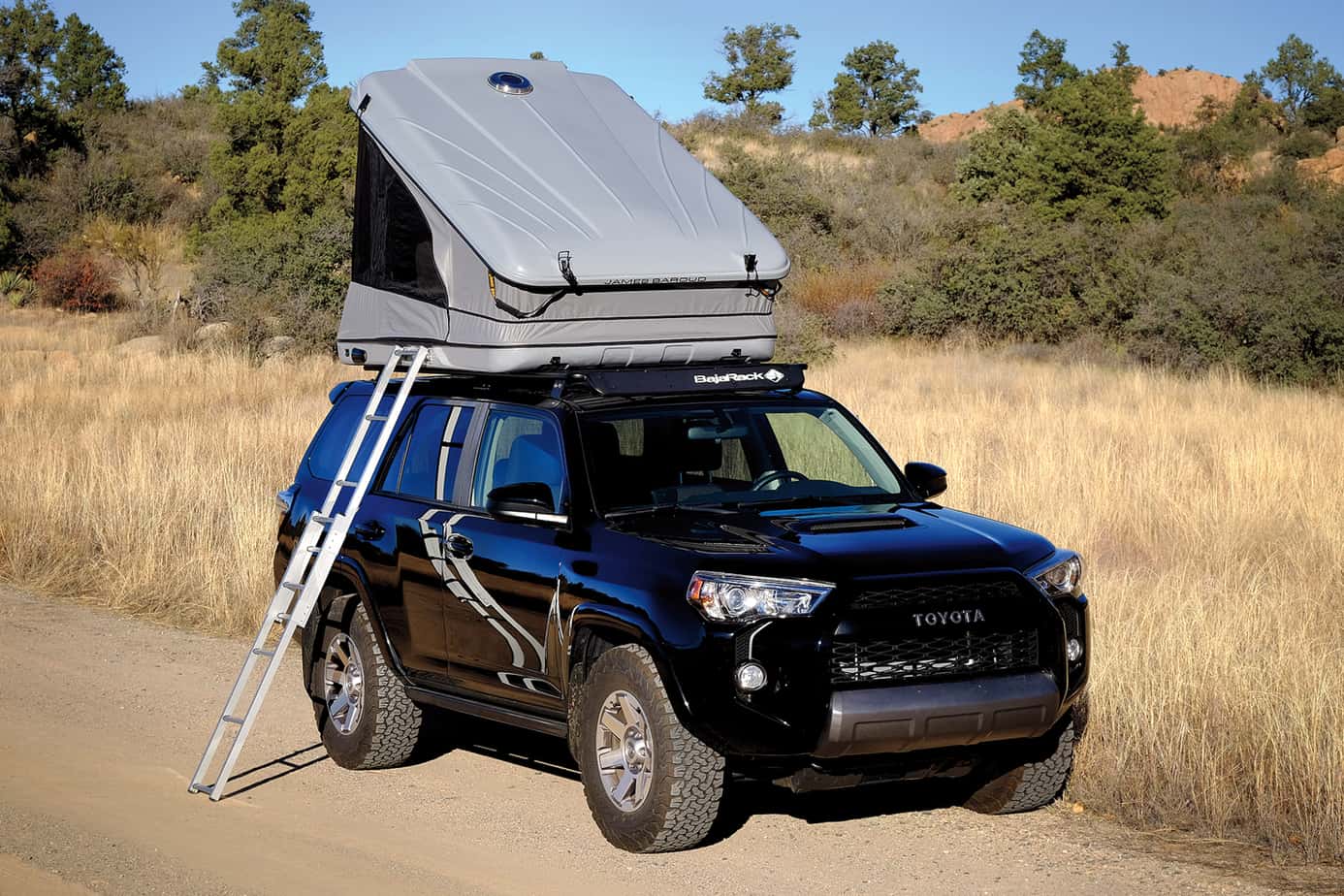



James Baroud calls it a raked roofline. Engineered to mitigate the disadvantages of the wedge shape without limiting its benefits, the Discovery Space EVO is one of the more innovative tents in our test. Its high peak creates an enlarged wall with a corresponding oversized door. That bigger opening maximizes air pass-through and increases the ingress of natural light. With an additional 22 inches of vertical height at the foot of the tent, there is no hazard of contacting one’s feet against the upper shell. It is an efficient and clever use of space—hence the moniker.
The large rear opening and two side doors have partial mesh-backed panels, as do the dual windows at the rear corners. With all of the mesh windows exposed, the Space has impressive ventilation with a bright and airy interior. A hallmark of James Baroud tents, it is also replete with thoughtful appointments. In addition to a rechargeable and removable LED light mounted to the lined ceiling, there is a large cargo net to store items within easy reach. To eliminate the buildup of condensation and to keep airflow moving at optimum levels, a solar-powered electric fan can be used to direct air in or out of the tent body, even when the tent is sealed tight to fight off foul weather.
Known for their easy deployment, James Baroud tents use a well-designed strut system with gas rams to elevate the upper shell structure. With a quick walk around the vehicle to release four cam buckles, the Space gracefully springs into position with no input from the user. After attaching the ladder, completing setup involves a gentle nudge to lock the hinged support struts firmly in place. We did notice that a lot of force must be applied to collapse the tent, something that might be a consideration for some.
Whereas many of the shells themselves are constructed with unsophisticated shapes, the Space was designed for optimal aerodynamics. The sculpting of the outer shell features contours engineered to reduce noise and drag. On our test vehicle, the increase in measurable wind noise over an empty roof rack was negligible.
After the first dozen nights of use, the slanted roof of the Space made us question why more tents are not made in a similar fashion. The high peak and enlarged back door made it feel vastly larger than it really is and the slight reduction in headroom at the foot of the tent was barely noticeable. The large amounts of exposed mesh provide generous ventilation and keep the interior filled with natural light.
What we have come to admire about James Baroud tents is their level of ingenuity. Their proprietary aluminized synthetic canvas seems to be superior to fabrics used by other manufacturers; it is durable, resists mildew, and reflects sunlight and UV rays to help maintain a cool interior. Easy to set up, quiet on the highway, and offering useful living space, the Discovery Space EVO ticks all the right boxes for a high-quality travel shelter. jamesbaroudusa.com, 908-387-6701
BUNDUTEC
BunduTop $3,250

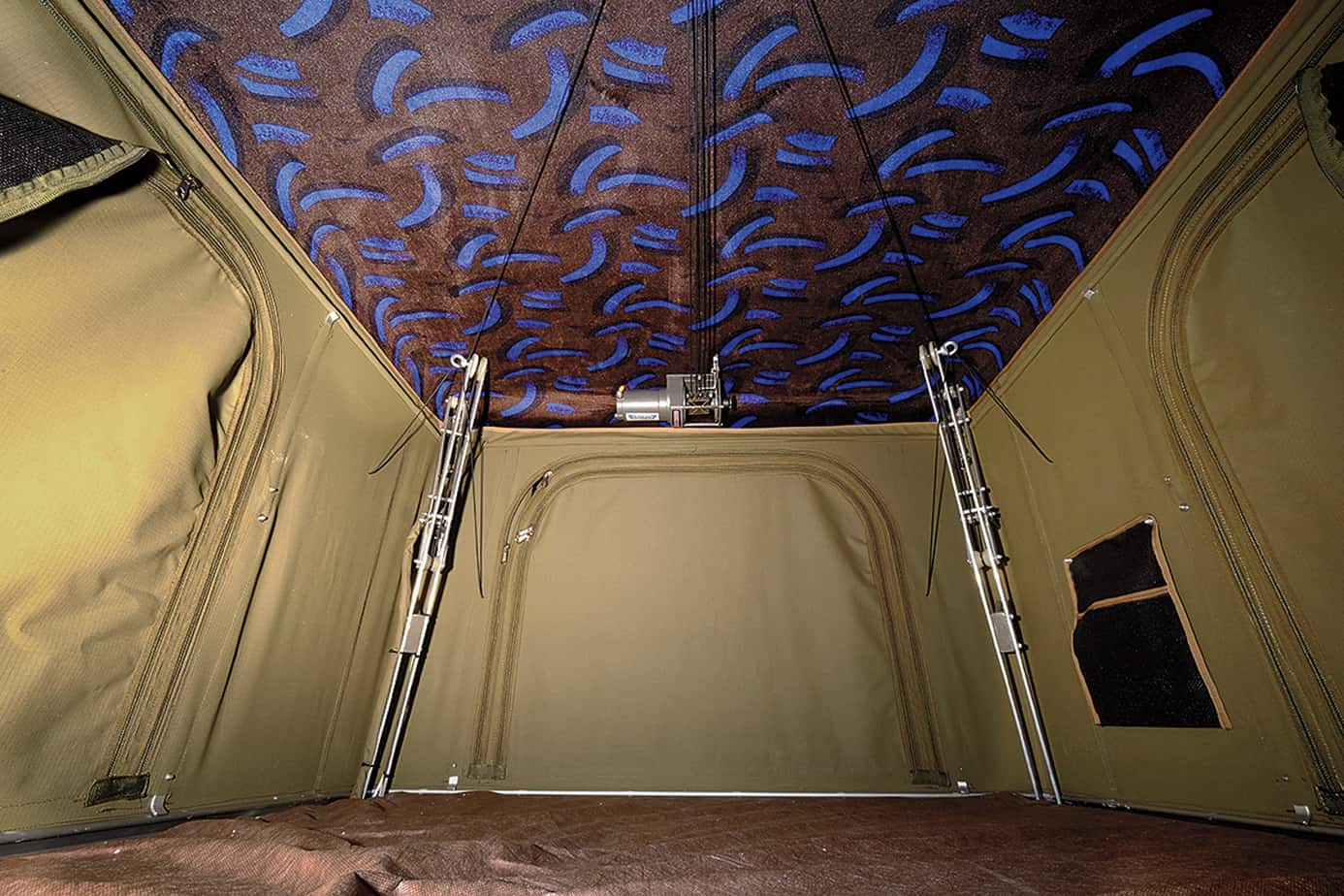


The award for the most unique rooftop tent, if we were to give one, would clearly go to the BunduTop from Bundutec. Despite the common usage of fiberglass in the other four tents, Bundutec elected to construct their shell from aluminum, citing it is as a lighter-weight alternative. Their need to keep overall weight to a minimum is precipitated by the inclusion of a 2,000-pound winch to raise and lower the upper tent body. At 151 pounds as tested, they did an admirable job of attaining their weight objectives.
It would be easy to fixate on push-button deployment as the only standout feature to the BunduTop, but it has much more to offer. With four vertical walls and a tall ceiling height of 40 inches, it is the most spacious tent in the group. The four equal-sized doors, each backed with mesh panels, let in large amounts of air and natural light adding to the sense of openness. The 4-inch-thick mattress is sublimely posh, although we wish it was wrapped in a more comfortable cover. The 360-degree awning is our favorite design element, fortifying weatherproof-ness and providing four-sided shade for the interior. Other appointments include a bright, hard-mounted LED light and 12-volt accessory outlet.
Prior to getting our hands on the BunduTop, it would be fair to say we were mildly skeptical of such an elaborate design and expected it to be delicate. The mechanisms that raise and lower the upper half involve an intricate and perplexing array of pulleys, hinges, straps, and spools of cordage. Fortunately, those components appear to be smartly engineered and robustly built, inspiring confidence that the system should be reliable over the long haul. We can say with confidence that the electric-assist function works flawlessly every time, opening and closing with the touch of a finger in just 30 seconds.
Impressed as we are with the smooth operation and overall livability of the BunduTop, there are a few aspects of design we would like to see addressed. The most critical is the ladder and its attachment. The two-piece ladder is not only crudely made, it is not adjustable and must be cut to length. The ladder attachment, or lack thereof, is little more than a small aluminum tray the user must bolt to the one entry point they choose to use. This, unfortunately, renders the other three doors to window duty.
The other quip is that the mounting system doesn’t include any fasteners or hardware. To install the BunduTop, the user must commit to a time-consuming process of drilling holes in the bottom of the tent and then bolting it to a base rack. Then the tent must be wired to the host vehicle, but no wiring components are provided. All of the other tents in this test employ a pair of tracks and sliding brackets and can be installed or removed in as little as 15 minutes. The initial installation of the BunduTop requires a minimum of two hours to complete. Once mounted, few will remove it unless forced to, making it a semi-permanent installation.
Despite this drawback, there is no denying the BunduTop is well made, cleverly designed, and easy to use. When erected, the walls and awning are tight as a drum, and the interior space offers a comfortable sanctuary in hot or stormy weather. The quality of materials is excellent and the button-operated convenience is sure to win over many overlanders. bundutecusa.com, 319-234-0071
AUTOHOME
Maggiolina Extreme $3,699
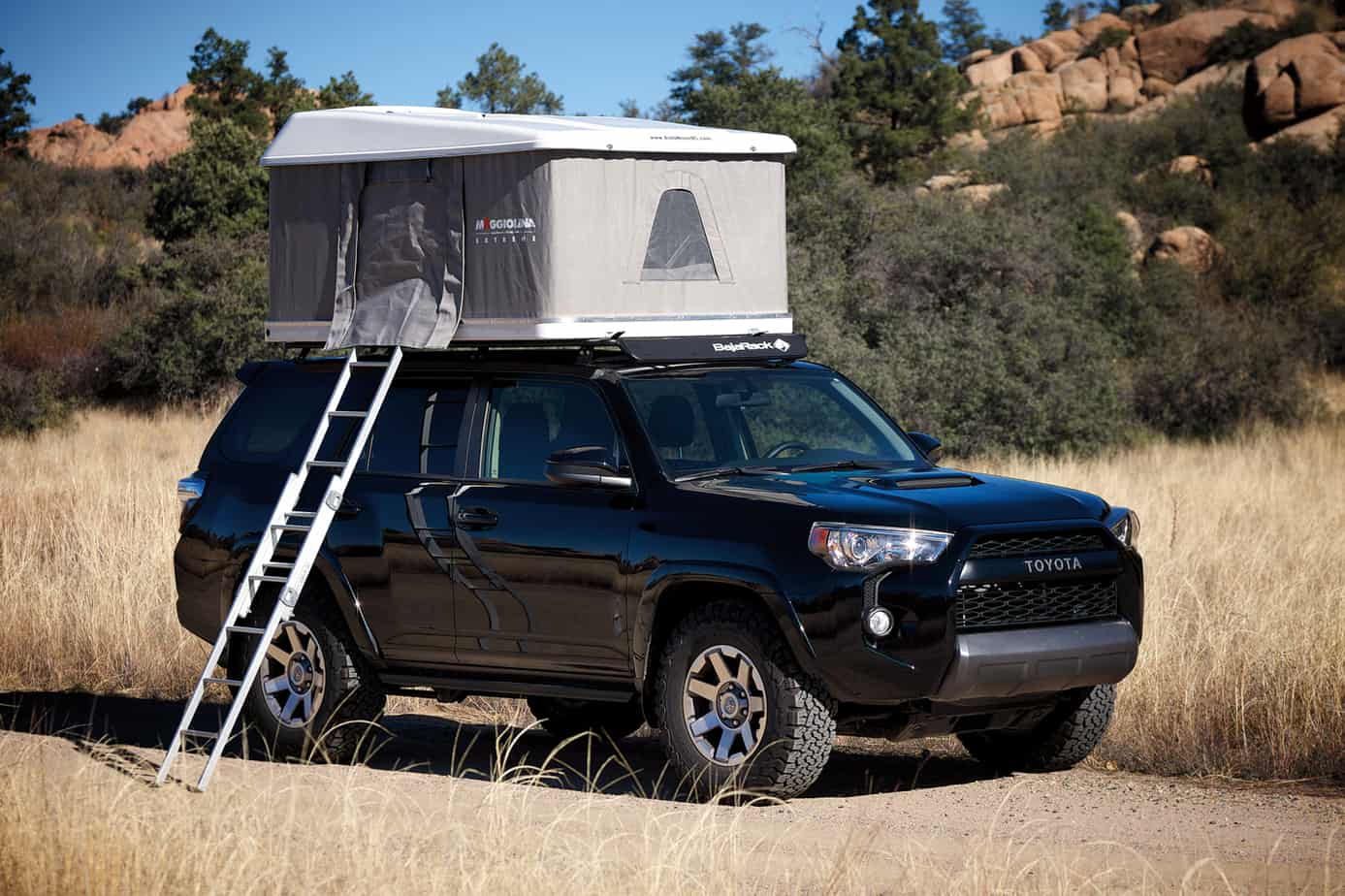

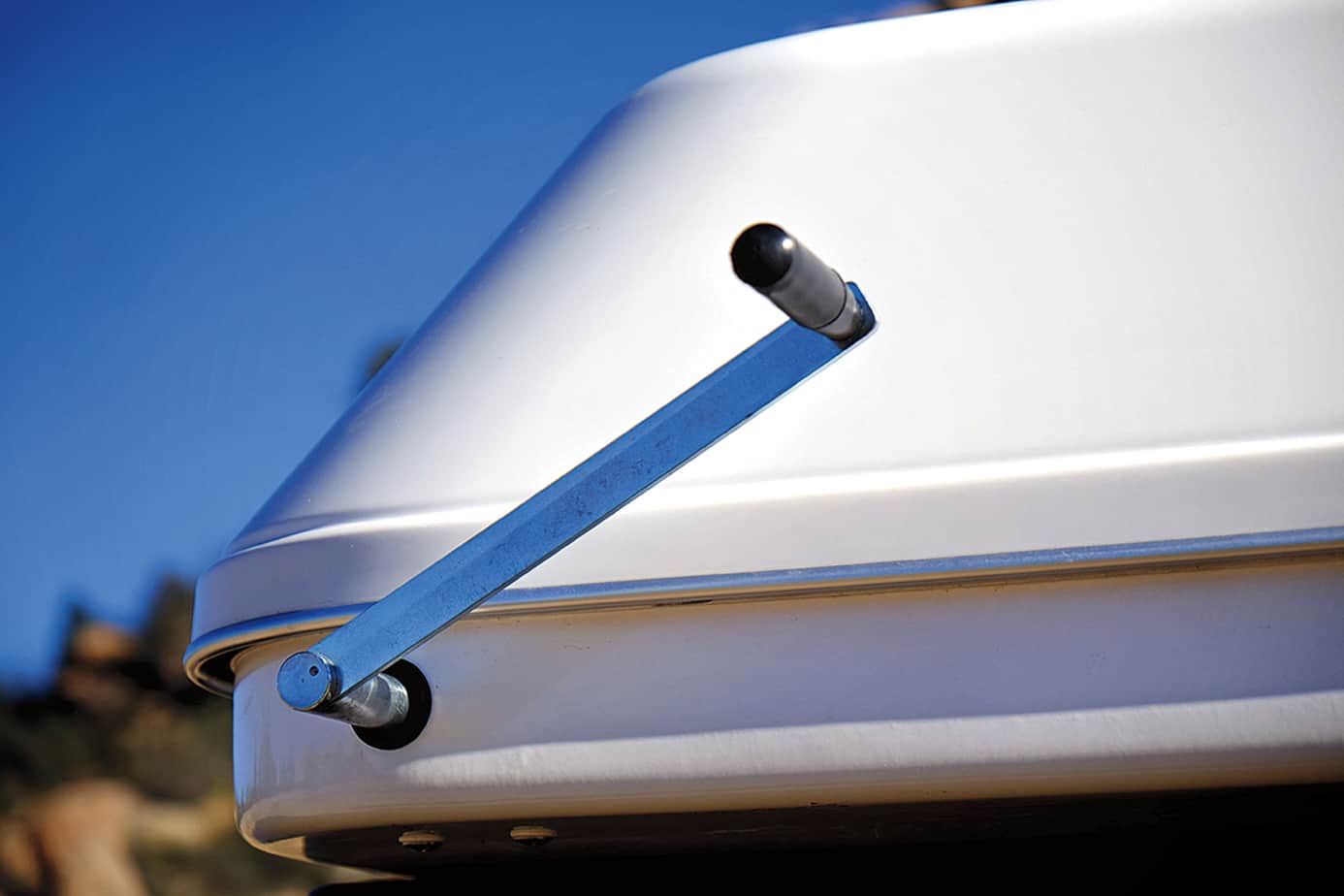

The Maggiolina is one of the most traveled roof top tents the world over. The recipient of occasional design updates throughout the years, the latest iteration of the Maggiolina Extreme is expressly engineered for the rigors of overland travel and includes features designed specifically for that purpose. The most noticeable is the addition of extra rack rails and crossbars atop the shell to facilitate additional cargo storage.
With a new shape optimized for improved aerodynamics, the Extreme still retains the unmistakable profile of an Autohome tent. The distinctive hump at the aft end of the body affords extra internal storage space when closed and adds to its wind-cheating efficiency on the highway. When opened, the four vertical walls, combined with a 34.5-inch ceiling height, give the Extreme an open living space. The advantage to a horizontal roofline, even at the sacrifice of a lower peak height, is the ability to move about the entire floor plan unencumbered. For two occupants this allows each to assume their own space at either end for added elbow room or sitting out a storm.
Constructed with durable Dralon acrylic canvas, the walls offer optimal storm-worthiness without negatively affecting breathability or compounding condensation. The lined ceiling reduces moisture buildup, and the mesh-backed doors and windows help promote air circulation. The two side doors and the small windows at each end have mesh panels, although the windows could be larger.
Inside there are a number of refinements which make the space a comfortable habitat. An LED lamp casts even light throughout the interior, and four removable pockets along the sidewalls keep items organized. A cargo net along the ceiling panel adds storage options. The three included pillows are surprisingly soft and the red accents on the zippers make them easy to locate in low light.
Unlike the other tents in this test which all have gas-or electric-assisted deployment, the Extreme uses a manual hand crank. Simple and reliable, it is also necessary to generate the extra lifting force required to raise the additional weight of items stored atop the rack on the upper shell. The cranking action is smooth, requires little effort, and can have the tent fully extended in a little more than a minute. We found the crank to be an easier means of collapsing the tent over the gas-charged strut systems, even with the large number of crank revolutions required. Some users have even adapted cordless drills to perform the cranking.
When carefully inspecting the design and build quality of the Maggiolina Extreme, the 57-year legacy of Autohome is evident in every detail. The stitching is precise, the appointments well-thought-out, and the joints between various components are executed with exacting tolerances. There is a sense that Autohome has been tireless in their pursuit of a perfect product.
What makes these comprehensive tests so enlightening is the ability to not just evaluate each offering based on its own merits, but to be able to compare them directly with their peers. Although it could be filed under the category of extreme nitpicking, the Maggiolina’s two smallish windows seem insufficient when compared to the enlarged corner windows and third door offered by the James Baroud Evasion EVO. Regardless of that criticism, the Maggiolina Extreme is worthy of the brand’s reputation and asserted itself as a pinnacle product in its category. If there was one singular takeaway from our evaluation of the Extreme, it would be summed up with one word—quality. autohomeus.com, 888-852-2359
JAMES BAROUD
Evasion EVO $3,400

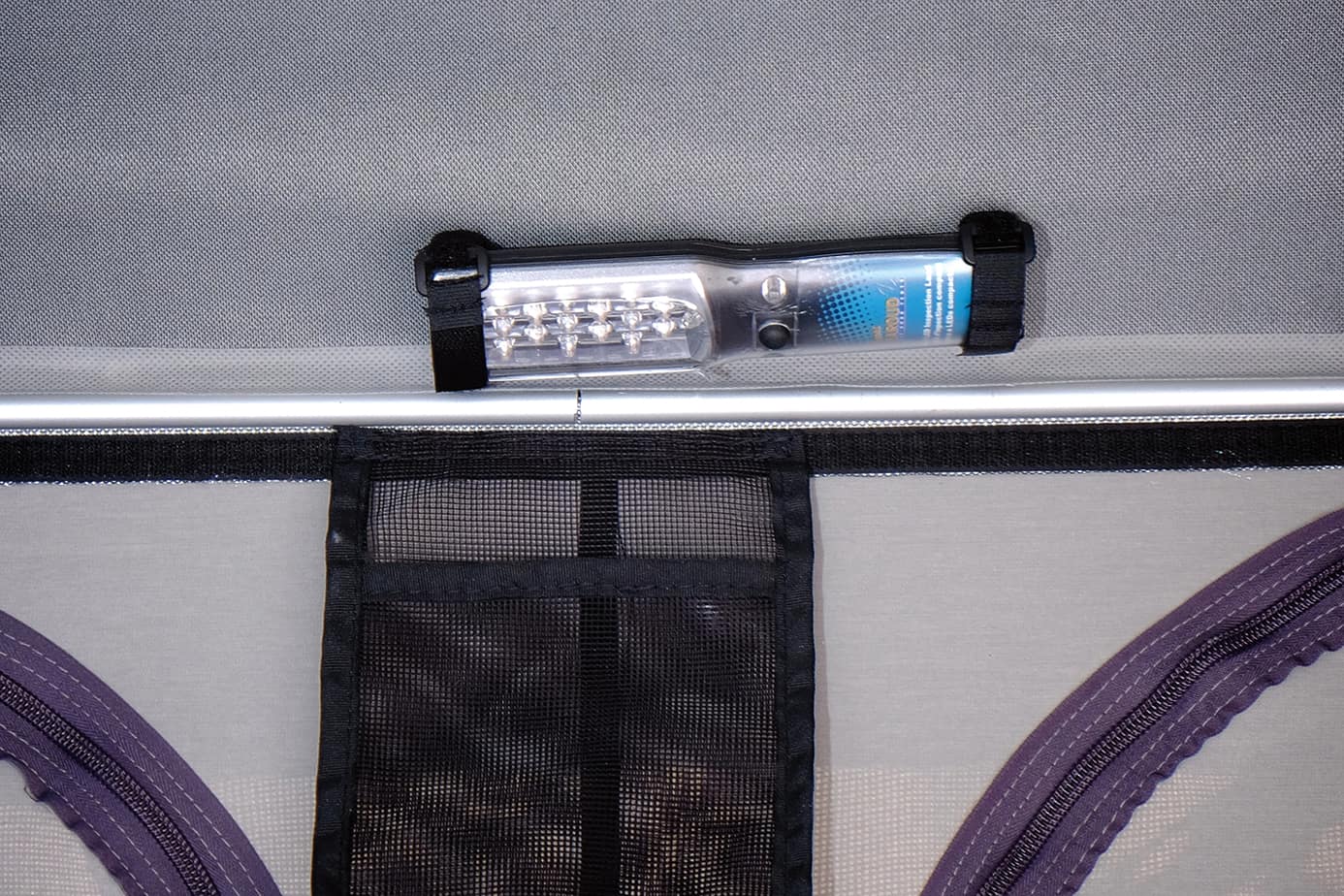


We first tested the Evasion EVO two years ago atop Overland Journal’s Land Rover LR4. It was our introductory experience with James Baroud and at that time we would have been hardpressed to offer suggestions for improvement, but improve it they did. The latest model has better ventilation and a simplified construction.
The Evasion we evaluated previously scored favorably due in part to the three full-size doors and one large window. Although it didn’t seem possible, they have added even more windows and true 360-degree viewing. Retaining the mesh paneled doors at the sides and rear of the tent, the new Evasion now has two small windows at the rear corners and two massive windows covering the forward corners and front wall. When fully exposed, the mesh panels expose more than 50 percent of the overall tent body. For those of us in the Desert Southwest, the level of ventilation provided by the new Evasion is welcome relief from oppressive heat, particularly when paired with the reflective aluminum-coated canvas.
Built with the same upper and lower shell components as the Discovery Space EVO, the Evasion shares its slippery aerodynamics and nearly all of the same features. It too has a solar-powered fan, LED light, cargo net, and gas ram assisted deployment. Whereas the Space has a taller interior peak at the tail end, the Evasion has superior air pass-through on all four sides.
For users of average height, the 34-inch-tall horizontal ceiling of the Evasion affords ample room to sit up and move about the full interior of the shelter. For people with a longer torso and a need for more sitting height, the Space is the better alternative.
Another benefit of the abundant use of mesh is the ability to precisely adjust air pass-through for maximum effect. This reduces condensation and can help control the desired temperature within the shelter. It also allows the occupants to block morning light on one side of the tent while leaving the other side open. This enhances the livability of the tent better than any other attribute.
While the new Evasion first appears to be more of an evolution, it is, in reality, a considerable redesign. No other tent we have tested, hard or soft, presents such an open-air experience with nearly every wall covered in mesh. Due to so many zippers folded into its design, we expected some degradation to its weatherproofness. To our surprise, after trying to force water into various seams and panels, we couldn’t get much more than a drop or two to enter the interior.
As much as we have enjoyed using the Discovery Space and both generations of Evasion, there is one recurring grouse we attribute to all James Baroud tents. Although the ladder attachment has been improved and is now more secure, some members of our team have experienced problems associated with its nonlocking design causing it to abruptly slide out of position. Others have made no mention of such an issue, but we felt it was worth noting. jamesbaroudusa.com, 908-387-6701
Conclusions
Given the reputations of the products we tested, there were not many surprises. The negatives and missteps we uncovered were so minor, none should be considered a deal breaker. When paired to a set of specific user needs, any of the five would be a sound choice providing years of comfort and service. Every tent displayed thoughtfulness of design, and a commitment to build quality consistent with premium products.
The BunduTop entered into our evaluations as the great unknown, but proved it deserved its place within such an esteemed group of tents. After careful review, our team agreed it would be an excellent choice for use on a trailer where the semi-permanent mount is a non-issue. The least aerodynamic of the bunch, the added wind noise, although minimal, would also be inconsequential on a trailer. Impressively engineered, it is the most effortless tent to deploy and stow.
We knew Autohome would be a top performer, and both the Columbus Variant and Maggiolina Extreme demonstrated why they have both earned loyal followers around the globe. The Columbus Variant is elegantly simple, quickly set up, and surprisingly comfortable. As the lead tester, the more I used it, the more I appreciated its unfettered design and precise construction. At the price of some soft-sided tents, it wins our Value Award.
The Maggiolina Extreme with its manual crank could be mistakenly dismissed as a lesser product when compared to the gas ram assisted alternatives. It may add a few seconds to deployment, but is uncomplicated and requires minimal effort. During the stowing procedure, the crank allows the user to easily tuck the tent fabric without having to suppress the tension of gas struts, thus simplifying the process. The Dralon fabric also has the classic feel of durable canvas, an added touch we appreciated.
When it came time to hone in on a winner for our Editor’s Choice award, I had to resort to my scorecards, notes, and critical assessments from the other evaluators. As the lead tester, there are elements to the James Baroud Discovery Space that would make it my personal choice. The extra headroom and ability to kneel within the tent was the tipping point. In the end, though, it was the 360-degree ventilation and bright interior of the Evasion that gave it the advantage. Its ability to defend against the worst assaults from wind and rain is impressive, but the warm weather performance is what pushed it to the top of our list. With several months of testing behind us, the evaluations continue, and why not? It makes for a great reason to hit the road.
Comparison
